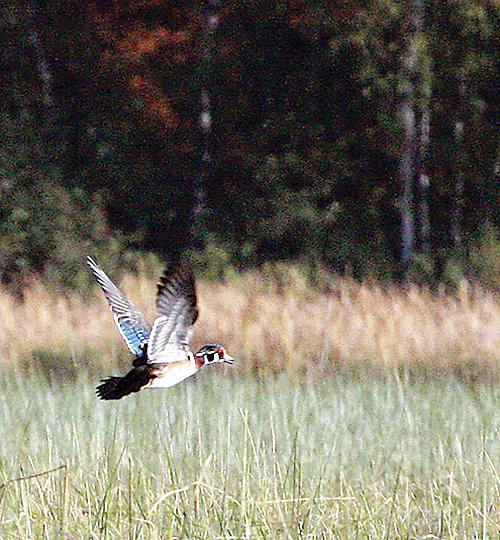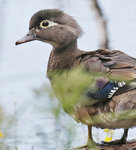Support the Timberjay by making a donation.
A woodie’s world
For a momma wood duck, raising young is always a challenge
The soft, yet insistent cry told me that waiting in my camo just might be rewarded. I was standing not far from the shore of one of our local beaver ponds, where I had searched unsuccessfully for …
This item is available in full to subscribers.
Attention subscribers
To continue reading, you will need to either log in to your subscriber account, or purchase a new subscription.
If you are a current print subscriber, you can set up a free website account and connect your subscription to it by clicking here.
If you are a digital subscriber with an active, online-only subscription then you already have an account here. Just reset your password if you've not yet logged in to your account on this new site.
Otherwise, click here to view your options for subscribing.
Please log in to continue |
A woodie’s world
For a momma wood duck, raising young is always a challenge
The soft, yet insistent cry told me that waiting in my camo just might be rewarded. I was standing not far from the shore of one of our local beaver ponds, where I had searched unsuccessfully for wood ducks a number of times before.
These ducks, particularly the males, are so spectacular that they’re like a magnet for anyone interested in wildlife photography. They’re also among the wariest of our native ducks, which makes them a more challenging subject than many other waterfowl. I’d had few opportunities over the years, and none in which I had gotten within range for a quality shot.
I had been photographing a female blue-winged teal, when she suddenly caught a slight movement of mine and began moving away, slowly enough to let her single surviving duckling catch up.
The teal’s sudden departure seemed to attract the attention of a female wood duck that had given a soft call a few moments earlier. The full shrill cry of the wood duck is distinctive, unlike any other North American duck, so even though this duck offered a much softer version, there was little doubt that a “woodie” was somewhere nearby on this sprawling pond.
Soon enough, I caught movement. I’ve noticed over the years that ducks are naturally curious when they feel secure in their habitat and it seemed this wood duck was coming by to check out what had caused the teal to leave. This time, I was sure to remain stock still, confident that my camouflage would do its job.
As she approached my position, she eyed me closely, as if she knew I was there, but didn’t know what I was, and clearly didn’t see me as a threat. Like the teal, this mother was leading one remaining duckling, a sad reminder of just how merciless nature can be on the young. Wood ducks typically lay 10-15 eggs, so I was sad to think that all of this lonely duckling’s siblings had already perished, most likely in the clutches of a hawk.
Wood ducks are unusual ducks in more ways than one. While most North American ducks prefer more open terrain, like prairie potholes, the wood duck is a true forest denizen. They nest in tree cavities, although they’ll also use human-created nest boxes, and are able to perch on tree branches thanks to a clawed foot that gives them a better grasp. Those claws also help the newly hatched ducklings climb out of their nest cavity. The ducklings leave the nest within a day of hatching and they jump to the ground or water below as they do. Wood ducks can nest as high as 60 feet in the air, so that first step into the wider world can be a doozy.
Wood ducks also have a much longer tail than most other ducks, which provides them greater maneuverability as they fly through the woods.
The wood duck was, for a time, extremely rare, mostly due to habitat loss and overhunting. But a hunting ban, and the regulated harvest that followed, has allowed the species to recover. Greater conservation efforts, such as the building of nest boxes, have also helped. Here in the North Country, the proliferation of the beaver has been another boon, since they can provide excellent habitat for wood ducks.
If you have a beaver pond near you, consider putting up a nest box. Plans for boxes can be found online. It’s best to erect the box on a tree or post that’s standing in the water to discourage predators. If that’s not possible, wrap some metal flashing around the tree trunk to keep predators at bay.
While I would have liked to have spotted a male wood duck during my recent visit, that was unlikely. Male ducks, including male woodies, have little or nothing to do with rearing offspring. They typically spend the summer hanging out with other males, while the females are the ones stuck with the young ones. Sound familiar?











